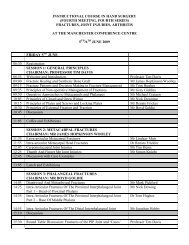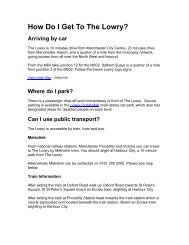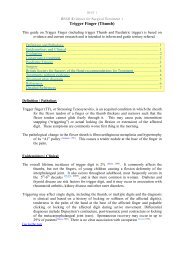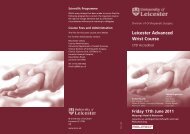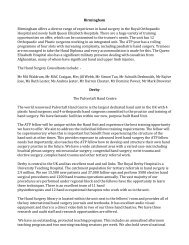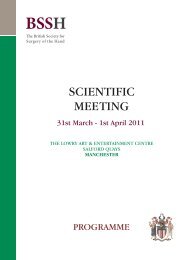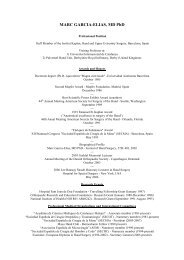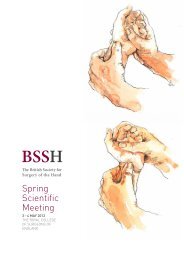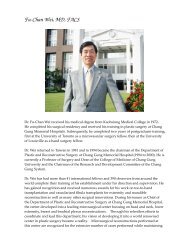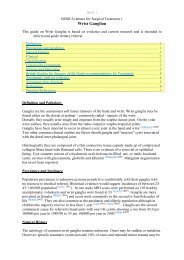here - The British Society for Surgery of the Hand
here - The British Society for Surgery of the Hand
here - The British Society for Surgery of the Hand
You also want an ePaper? Increase the reach of your titles
YUMPU automatically turns print PDFs into web optimized ePapers that Google loves.
POSTERS<br />
deployed troops during activities unrelated to war fighting. Articles concerning military hand trauma management<br />
were mainly published prior to <strong>the</strong> conflicts <strong>of</strong> <strong>the</strong> last decade. Within <strong>the</strong>se papers injury classification and<br />
treatment priorities are highlighted as core knowledge <strong>for</strong> trauma surgeons.<br />
Conclusion: This paper provides a review <strong>of</strong> conflict related injury patterns with special regard to hand trauma.<br />
<strong>The</strong> key learning points from historical literature are highlighted. Proposals <strong>for</strong> improving management <strong>of</strong> <strong>the</strong>se<br />
injuries from battlefield to home nation are discussed with regard to training opportunities and dialogue to<br />
ensure past lessons are not <strong>for</strong>gotten.<br />
6 <strong>The</strong> Posterior Lateral Approach to <strong>the</strong> Distal Humerus<br />
Mr D E Deakin, Mr P Dhillon, Mr S C Deshmukh (Birmingham)<br />
Introduction: Several posterior approaches to <strong>the</strong> elbow have been described. We present a new approach to <strong>the</strong><br />
elbow via <strong>the</strong> lateral border <strong>of</strong> <strong>the</strong> triceps muscle.<br />
Operative Technique: A posterior midline incision is made and <strong>the</strong> skin and subcutaneous tissue are reflected.<br />
<strong>The</strong> ulnar nerve is identified. A plane is developed between <strong>the</strong> lateral border <strong>of</strong> <strong>the</strong> triceps and <strong>the</strong> lateral<br />
intermuscular septum. As this plane is continued distally <strong>the</strong> fascia covering anconeus muscle is divided. <strong>The</strong><br />
distal insertion <strong>of</strong> anconeus is partially detached exposing <strong>the</strong> medial ulnar. As <strong>the</strong> triceps mechanism is reflected<br />
medially, <strong>the</strong> origins <strong>of</strong> flexor carpi ulnaris (FCU) and flexor digitorum pr<strong>of</strong>undus (FDP) are partially reflected<br />
subperiosteally from <strong>the</strong> lateral border <strong>of</strong> <strong>the</strong> ulnar. <strong>The</strong> ulnar nerve lies undisturbed on <strong>the</strong> outside <strong>of</strong> <strong>the</strong> medially<br />
reflected triceps.<br />
Discussion: We have used this exposure routinely <strong>for</strong> total elbow replacements and fixation <strong>of</strong> intraarticular<br />
fractures <strong>of</strong> <strong>the</strong> distal humerus in ten patients since 2005. No cases <strong>of</strong> post-operative ulnar nerve neuropraxia or<br />
wound problems have been encountered. Previously described approaches include <strong>the</strong> olecranon osteotomy,<br />
lateral reflection <strong>of</strong> <strong>the</strong> triceps and triceps-splitting approaches. This approach has not been described. Nonunion<br />
rates associated with olecranon osteotomy are 2%. Lateral reflection <strong>of</strong> <strong>the</strong> triceps involves mobilising <strong>the</strong><br />
ulnar nerve and post-operative ulnar nerve neurapraxia has been reported in <strong>the</strong> region <strong>of</strong> 10%. Splitting <strong>the</strong><br />
triceps disrupts <strong>the</strong> extensor mechanism. This approach avoids <strong>the</strong>se problems, whilst still achieving excellent<br />
exposure <strong>of</strong> <strong>the</strong> distal humerus and proximal ulnar.<br />
7 Carpal Tunnel Syndrome: Validation <strong>of</strong> a Clinic Based Nerve Conduction Measurement Device<br />
Mr T Green, Dr M Kallio, Dr V Lesonen, Pr<strong>of</strong>essor U Tolonen, Mr M Clarke, Mr P Pathak (Leicester/Oulu)<br />
Introduction: Measurement <strong>of</strong> sensory latencies across <strong>the</strong> wrist in carpal tunnel syndrome can now be per<strong>for</strong>med<br />
by non-specialists using commercially available devices. One such device, Mediracer, has been suggested by <strong>the</strong><br />
UK Department <strong>of</strong> Health as being worthy <strong>of</strong> fur<strong>the</strong>r assessment (Trans<strong>for</strong>ming clinical neurophysiology diagnostic<br />
services to deliver 18 weeks - DoH 2007). Our study compared this device against standard neurophysiological<br />
measurements.<br />
Methods: Sixty-three subjects were recruited. All were referred complaining <strong>of</strong> symptoms in one or both hands,<br />
such that it was thought <strong>the</strong>y might have carpal tunnel syndrome. <strong>The</strong>y were consented to receive bilateral<br />
traditional nerve conduction studies carried out by neurophysiologists and new device measurements carried out<br />
by Orthopaedic staff. <strong>The</strong> study was approved by <strong>the</strong> Ethics Committee.<br />
Results: <strong>The</strong> latency differences between ring finger stimulation evoked median nerve peak latency (4PM) and<br />
ulnar nerve peak latency (4PU) were compared using regression analysis. <strong>The</strong> latency differences between index<br />
finger stimulation evoked median nerve peak latency (2PM) and ring finger stimulation evoked ulnar nerve peak<br />
latency (4PU) were compared using <strong>the</strong> same analysis.<br />
4PM-4PU latency difference between traditional studies and <strong>the</strong> new Mediracer device had a correlation coefficient<br />
<strong>of</strong> 0.88 (p



